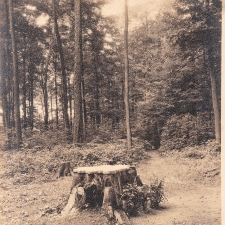
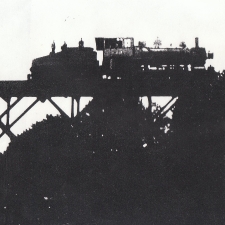
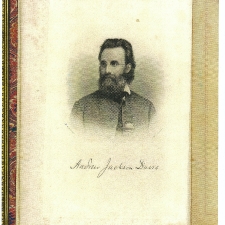
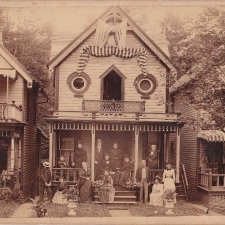
1880
Spiritualist Camp Meetings
Emma Hardinge Britten, “Spiritual Camp Meetings,” Nineteenth Century Miracles; or, Spirits and Their Work in Every Country of the Earth. A Complete Historical Compendium of the Great Movement Known as “Modern Spiritualism.” New York: William Britten, 1884, pp. 542-550.
[Partial quote from–http://www.spirithistory.com/80camps.html]
To a visitor who has never before beheld, or taken part in such a scene, a Spiritualistic camp meeting produces an indescribable feeling of strangeness and bewilderment, which scarcely allows him to determine whether he is under the influence of pleasure or pain. The gatherings are so vast, the scenes so new, and each member of the busy crowd seems so intent on pursuing his own special avocation, that a sense of loneliness, even of desolation, such as if often experienced by strangers in thronged cities, almost invariably possesses the sensitive mind. Gradually, the multitude of objects crowding in upon view on every side, arrange themselves into order, and then the sight is one of endless interest and amusement. To a lounger passing through the various groups, some arranged in picturesque knots at the tent doors, others reclining beneath shady trees, or stretched out upon grassy knolls, the fragments of conversation that meet the ear are as curious and heterogeneous, as the objects that appeal to the sense of vision. From the first peep of day, the campers are astir, lighting gipsy fires, preparing breakfast, and trading with the various hawkers who ply with their provisions regularly through the white-tented streets. After the morning meal, visits are exchanged, and the business of the day proceeds with as much energy and order as in the cities. Sailing parties, séances, amusements, and business, all proceed in due course, until the hour for speaking arrives, when thousands assemble at the speaker’s stand, to partake of the solid intellectual refreshment of the day. Lectures, balls, parties, illuminations, public discussions, &c., &c., fill up the time until midnight, when the white tents enclose the slumbering hosts; the fires and lamps are extinguished, and the pale moonbeam shines over rocks, groves, and lakes, illumining scenes as strange and picturesque as ever the eye of mortal gazed upon. Resembling to some extent a martial camp, but adorned with flowers, wreaths, and emblems of taste and beauty, instead of the grim paraphernalia of war, the stern sentinel with musket in hand is exchanged for watching angels. Instead of the savage password, “Death and glory,” “Life eternal” is whispered in every breeze that stirs the tree tops, and the white tents, instead of sheltering the fever-racked forms of mailed victims, only waiting for the shrill cry of the bugle to marshal them to murder or death, shade the peaceful slumbers of those who know no death, and who are tenderly guarded by the glittering rank and file who have triumphed over the grave, and risen as immortal victors from life’s cruel battlefields.
Amongst those who greet you as you take your morning’s walk from street to avenue, or linger on rocky pinnacles to contemplate the busy hive of life thronging below, are strangers from States a thousand miles off, and neighbours from the next village. You may talk politics with a white-haired knot of grandsires sunning themselves on a social bench, around an ancient elm; talk metaphysics with a group of lecturers assembled “from the four corners of the earth,” hear some merry “Indian maid” pouring out through the lips of her entranced “medy,” shrewd philosophy.
History of Lily Dale
The History of Lily Dale Camp is one of courage, stamina and dedication. It all began in the year 1844 – preceding the Hydesville manifestations by the Fox sisters. In the small village of Laona, a few miles from Lily Dale, Dr. Moran (mesmerist from Vermont) was invited by William Johnson, to lecture before a group of interested people. Mr. Johnson the son of a minister was the father of Marion Skidmore who became a great leader for Spiritualism at Lily Dale. At that time Jeremiah carter, physically enfeebled, had sought to be treated by Dr. Moran. Unfortunately Dr. Moran had to leave before such could be applied. Mr. Johnson suggested that they themselves try the experiments, demonstrated by the Vermont doctor. The results were startling. Mr. Carter became entranced. An entity to be a Dr. Hedges spoke to the people present – giving messages from spirit and demonstrating the laying on of hands.
The advent of the Hydesville manifestations strengthened the purpose of the group and they termed themselves Spiritualist and Liberals. The group met regularly to discuss their beliefs and practice their healing and mediumship. Many great speakers and mediums had their early beginnings in Laona. In 1855 the First Spiritualist Society of Laona was formed.
In 1873 Willard Alden owned a good size farm (now known as the Leolyn Hotel and woods) just outside the gates of Lily Dale. Jeremiah Carter insisted that spirit voices kept continuously urging him to go to Alden’s farm and start a camp meeting. This was accomplished and the group met there for summer picnics and camp meetings. After Mr. Alden’s transition, his heirs became dissatisfied with financial arrangements, so the board in 1879 decided to purchase land and move their location. Twenty acres of land was purchased from John Fisher at the price of $1845. This is now known as the Lily Dale Assembly.
Mrs. Amelia Colby was asked to name the camp. Her guide gave her the name of Cassadaga Lake Free Association. In 1903 the name was changed to The City Of Light and in 1906, The Lily Dale Assembly: named for the abundance of lilies on the lake.
Men and women worked tirelessly side-by-side, felling trees, clearing brush and making winding paths through the forest. The first service was held at Lily Dale under a cradle of boughs known as The Bough House, fashioned from entwining branches and flowers. Rough-hewn logs were used for benches.
The first speaker at Lily Dale was Elizabeth Lowe Watson. She was a dynamic speaker, a liberal and suffragette.
Financial problems were experienced from the early beginning of the camp, this acted strangely enough, not as a deterrent, but as a challenge to go forward and work harder towards the anticipated goal. The first order of business of the camp was the discussion of building a permanent Auditorium. This was accomplished in 1883, and later remolded in 1901. The seating capacity was twelve hundred. There has been many times during Lily Dale’s history that people stood three deep outside the auditorium in order to hear the lecture.
Preceding the auditorium in 1881, a Lyceum was formed with the children meeting in a tent. They felt that training of the young was important. In 1928 the Andrew Jackson Davis building for the Lyceum was built and gifted to Lily Dale by Mrs. M. Cadwallader, the editor of “The Progressive Thinker.”
In 1895 the Alden House was purchased by Mrs. Abby Louise Pettengill and renamed The Leolyn after her granddaughter. The Assembly then purchased the Leolyn from Mrs. Pettengill.
A hotel was built in 1880. It originally was the horse barn. It is known as a “hung suspension building.” When additional floors were needed each floor was raised and the new additions placed underneath. It was known as the Grand Hotel – today it is the Maplewood Hotel.
Today the Maplewood Hotel stands serenely, her old time charm still intact, overlooking the lake enticing the occupants to relax on its wide porch, and watch the ducks and swans, glide by. Many philosophical subjects have been debated and aired on the Maplewood porch. Bit by bit these sturdy pioneers plodded forward – roads were built, sewers installed, lights became a reality. The first Library was held in a tent in the park in 1886. Today it stands proudly as the Marion Skidmore Library housing thousands of the finest books on Spiritualism.
The Assembly Hall, famous for it’s thought exchange and class work came into being in 1888, the old school building in 1890. The Octagon Building was reserved for class, arts and the teaching of proper dancing. It housed the Junior League for years then became the “mediums’ building. The beautiful Healing Temple was built by Louis Vosberg at the direction of T.J. Kelly’s guide. This National Missionary was one of the most outstanding mediums that has served the Lily Dale platform. Incidentally, the famous actress Mae West, a friend of Jack Kelly visited Lily Dale at his invitation.
The original fox Cottage was moved from Hydesville, New York, a gift from Benjamin Bartlett of Cambridge Springs, Pennsylvania and placed at Lily Dale in 1915. Tragically the cottage burned to the ground early morning in 1955. Fortunately the Peddler’s trunk and family Bible were saved.
In 1898 Lily Dale had it’s own newspaper, The Sunflower. The editor was William Bach, who with his wife Evielena erected the Sunflower Pagoda. The United States Government in 1888 established the Lily Dale Post Office ensuring the inhabitants not only the convenience of it’s service but recognizing Lily Dale on the map.
From its lowly beginning of twenty acres, Lily Dale now owns approximately one hundred sixty acres.
Lily Dale has a splendid volunteer fire department. These men and women give freely of their time and efforts to protect the camp.
Truly Lily Dale lived up to that early promise. Thirty thousand people come through the gates each year. Lily Dale has comforted the bereaved, demonstrated the truth of immortality, and shown others a way of life known as the Religion of Spiritualism.
All of the people who visited Lily Dale contributed to “Beautiful Lily Dale.”
It is a worn cliché that the first hundred years are the hardest. If that is so, then Lily Dale has truly weathered the storms and kept the faith, knowing that the guiding light has been, and forever will be “the Eternal Light of Spirit.”
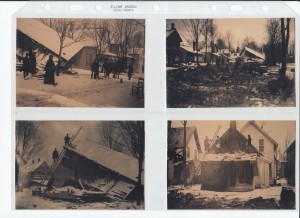 The Sunflower – January 1, 1901
The Sunflower – January 1, 1901
A long expected baptism of fire finally arrived. Friday morning December 28, at about 4:30 the people were awakened by hearing gunshots and a woman screaming and rushed to find the air lurid with the light of a fire.
When the residents arrived on the scene, the fire had so much of a start that it was useless to think of saving either of the cottages which were then afire and what goods were in the lower part were hastily removed and efforts made to prevent the further spread of the flames. C. B. Turner immediately placed two horses at the disposal of the people and one mounted by Clayton McCarthy went in one direction while another ridden by J. F. Witherall went over by Cassadaga and around Burnham giving the alarm that “Lily Dale was burning.
News spreads fast
The news spread like wildfire and teams were hastily hitched and in an incredibly short space of time, they poured into the gates loaded with men. By this time three cottages were burning fiercely and the prospects of saving any of the center of camp looked exceedingly dubious. With the arrival of assistance four squads of workers were arranged. One party went to work on the Scheu cottage on the corner of First Avenue and Cleveland, one on the cottage at the rear of the burning ones, one on the cottages across the street from the fire and the fourth decided to tear down a cottage and thus stop the flames spreading towards the East.
All worked with a will. A bucket brigade was organized, the women pumping water and carrying it equally as well as the men. Carpets, comforters and everything that would hold water was placed over the exposed portions of the buildings and while some carried water, others stood on the roofs and verandahs and kept the cloths wet, thus stopping the spread of the flames. Two teams were procured and holes were cut into the Wadsworth cottage (#12 1st), log chains attached and soon the building was drawn to one side partly torn down and snow shoveled upon the side toward the fire. Even after this, it caught fire and had to be extinguished with snow and water.
From one home to another
Precipitated Spirit Paintings are works of art produced through the mediumship of the Bangs sisters or Campbell brothers in the years from 1894 to about 1911 during séances in the light. No human hand was used—the entire process was by spirit communication. An iridologist examined the eyes of several of these, one of which was a portrait of President Abraham Lincoln.
The method of reception was much the same as the Bangs sisters’, except that the canvas was placed on a table, the paints placed in a receptacle beneath the table, then the table was covered with black cloth to eliminate the light, leaving the frame and canvas alone exposed.
The Campbell brothers sat with the sitters around the table with hands on the table to produce a concentrated battery. The picture was then precipitated in full view of the sitters.
The picture of Lincoln has been often copied and is considered a remarkable likeness of the great emancipator whose Spiritual development is a marked feature in this picture.
Lines on forehead might indicate a circulatory system problem. This man has many vertical lines at the bridge of his nose. This is considered a liver sign, could indicate an angry person. The liver holds the emotion of anger. The horizontal lines at the bridge of the nose indicate an insufficiency with the pancreas, sugar metabolism. Dark coloring in the corner of the eye indicates spleen insufficiency (possibly anemic).